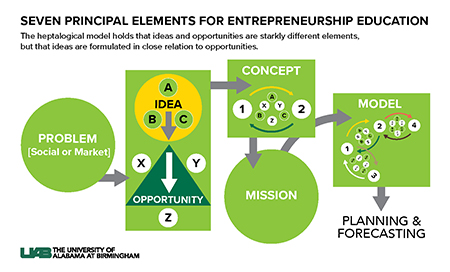Media contact: Tyler Greer
 Entrepreneurship is one of the most popular areas in business schools across the nation.
Entrepreneurship is one of the most popular areas in business schools across the nation.
According to the Kauffman Foundation, the number of entrepreneurship education programs has increased fivefold and the number of course offerings has increased 20-fold in the United States since the 1970s. To help support the evolution of business education, professors at the University of Alabama at Birmingham’s Collat School of Business recently published a framework of entrepreneurial phenomena designed for program development and educational activity.
“Despite this growth, the field has not yet established a distinct paradigm alongside other fields in the traditional domain of business studies as accounting, economics and finance have,” said Patrick J. Murphy, Ph.D., Goodrich Endowed Chair of Innovation and Entrepreneurship at UAB. “As a result, many students and employers regard a rigorous and transformational education in entrepreneurial competence as very attractive. However, the emergence of entrepreneurship major programs built intentionally to deliver those kinds of learning outcomes has not progressed as quickly as those stakeholders prefer.”
Published in Entrepreneurship Education and Pedagogy, the official journal of the U.S. Association for Small Business and Entrepreneurship, “The Heptalogical Model of Entrepreneurship” details a unique conceptual approach that is not prescriptive when it comes to entrepreneurial behaviors. The framework will serve as the conceptual foundation for the school’s academic entrepreneurship program. It is applicable to the radical diversities of entrepreneurial activity undertaken by many different kinds of entrepreneurs across sectors and communities.
“The model has developed for more than 15 years through utilization in several universities worldwide by my colleagues and me,” Murphy said. “At this point, it has been used in thousands of outreach projects with entrepreneurial ventures across a range of cultural and industrial settings in the United States and in other countries. I knew the time had come to publish it because we had finally stopped modifying its framework based on student and user feedback. It began to work very well.”
The model comprises seven principal elements in a systematic array. Its elements are tacit enough to be expressed via a range of different behaviors and actions.
It begins with social or market problems, from which opportunities emerge. These early stages inspire students with a strong problem-solving orientation in order to better understand how and where entrepreneurial opportunities tend to emerge and how to discover them.
The model holds that ideas and opportunities are starkly different elements, but that ideas are formulated in close relation to opportunities. The eventual integration of opportunity and idea generates a venture concept that is put into the context of a mission, which ultimately guides the growth of an entrepreneurial venture and sets the stage for strategic planning and forecasting. Each one of the model’s seven stages is necessary but not sufficient for the subsequent one to occur.
“Human beings are generally quite poor at managing growth and impact, which is what entrepreneurial activity is all about,” Murphy said. “Growth necessarily entails errors and uncertainties. This model is a paradigm for thinking about growth, errors and uncertainty in a way that is teachable to many different kinds of students in a formal way. It conveys the what, why, where and how of entrepreneurship without being overly prescriptive. This rigorous concept-based approach preserves the uniqueness and diversity that can be vital to entrepreneurial action, especially in the most radical ventures that are unlike anything the world has seen before.”
Murphy published the paper with Professors Anthony C. Hood of UAB and Jie Wu of the University of Macau.